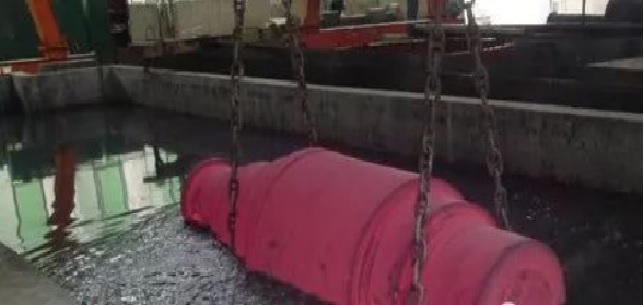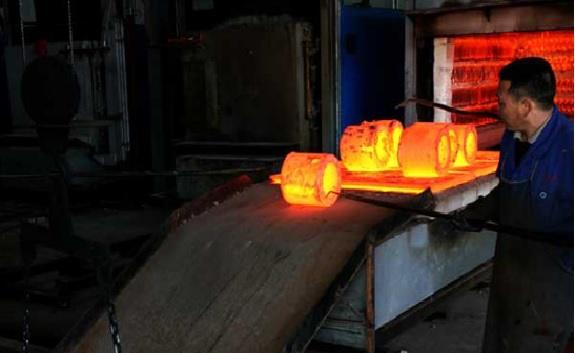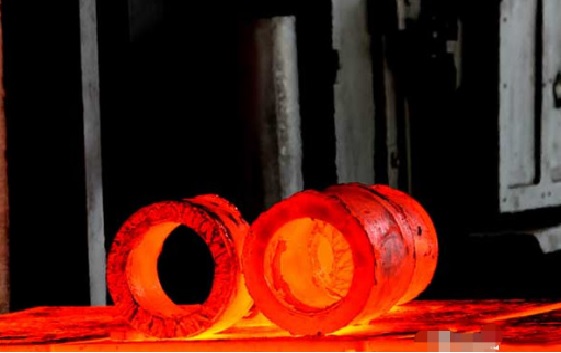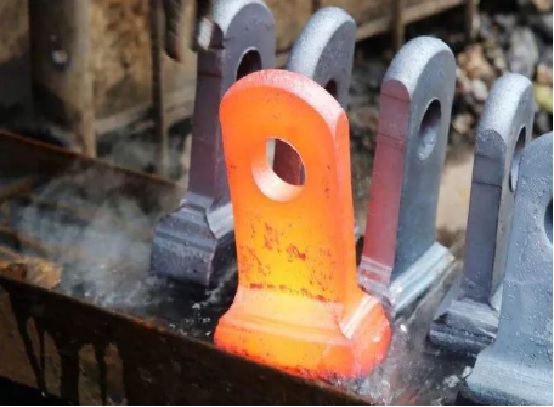Heat Treatment
What is Heat Treatment?
Heat treatment refers to a metal hot working process in which the material is in the solid-state, through heating, heat preservation and cooling to obtain the desired structure and performance. You can learn the following points from this article.
Basic Knowledge of Heat Treatment
Ten Processes of Heat Treatment
Seven Ways to Reduce the Deformation of Heat Treatment
Basic Knowledge of Heat Treatment
The heat treatment process generally includes three processes of heating, heat preservation, and cooling, and sometimes there are only two processes of heating and cooling. These processes are connected to each other without interruption. Heating is one of the important processes of heat treatment. There are many heating methods for metal heat treatment, the earliest is the use of charcoal and coal as the heat source, and recently the use of liquid and gas fuel. The application of electricity makes the heating easy to control without environmental pollution. These heat sources can be used for direct heating, or indirectly heated by molten salt or gold, or even floating particles. When the metal is heated, the workpiece is exposed to the air, and oxidation and decarbonization often occur (that is, the carbon content on the surface of the steel part is reduced), which has a very adverse effect on the surface performance of the part after heat treatment. Therefore, the metal should usually be heated in a controlled atmosphere or protective atmosphere, in a molten salt and in a vacuum, and can also be protected and heated by coating or packaging methods. The heating temperature is one of the important process parameters of the heat treatment process, and the selection and control of the heating temperature are the main issues to ensure the quality of the heat treatment. The heating temperature varies with the metal material being processed and the purpose of the heat treatment, but it is generally heated above the phase transition temperature to obtain a high-temperature structure.
1. Strengthen
Fine-grain strengthening: The grain boundaries of fine equiaxed grains are long, the distribution of impurities is more dispersed, and the difference in mechanical properties in all directions is small. The finer the grain, the better the strength, hardness, plasticity, and toughness.Solid solution strengthening: As the solute atoms enter the gaps or nodes of the solvent lattice, the lattice is distorted and the hardness and strength of the solid solution increase. This phenomenon is called solid solution strengthening.
Second phase strengthening: When the second phase metal compound particles are present in the alloy, the matrix (solid solution) metal around the particles is lattice deformed, and the interface between the substrate and the second phase is increased, both of which cause dislocations. Increased resistance to movement increases the strength and hardness of the alloy. The hardness and strength of the alloy are better than pure metals.
Heat treatment strengthening (phase transformation strengthening): the phase or structure is changed by the method of recrystallization.
2. Phase and organization
Ferrite: the interstitial solid solution of carbon in α-Fe (body-centered cubic structure iron).Austenite: interstitial solid solution of carbon in γ-Fe (face-centered cubic structure iron).
Cementite: a stable compound formed by carbon and iron (Fe3c).
Pearlite: a mechanical mixture composed of ferrite and cementite (F + Fe3c contains 0.8% carbon)
Leytenite: a mechanical mixture composed of cementite and austenite (containing 4.3% carbon)
10 Processes of Heat Treatment
1. Annealing
Annealing is a heat treatment process that heats the metal or alloy material to a certain temperature and keeps it for a period of time, and then slowly cools it. It is called annealing and slow cooling.The purpose of annealing:
A. Complete annealing and isothermal annealing are to eliminate the superheated structure and residual stress, at the same time can reduce the hardness, improve the plasticity and toughness, and improve the cutting performance.
B. Spheroidizing annealing in order to spheroid cementite in the steel, reduce the hardness of the steel, improve the machinability, and prepare the structure for the subsequent heat treatment.
C. Stress relief annealing and recrystallization annealing are not only to eliminate and improve the tissue defects and internal stress left in the previous process, but also prepare for the subsequent process, so annealing is a semi-finished product heat treatment, also known as a pre-heat treatment.

2. Normalizing (faster cooling than annealing) - Pre-heat treatment
Normalizing is a heat treatment method that heats the steel above the critical temperature, so that all the steel is transformed into uniform austenite, and then naturally cooled in the air. It can eliminate the network cementite of hypereutectoid steel. For normalizing of sub-eutectoid steel, it can refine the lattice and improve the comprehensive mechanical properties. It is more economical to replace the annealing process with normalizing for parts that are not demanding.3. Quenching (water cooling, oil cooling)
Quenching is to heat the steel above the critical temperature, keep it warm for a period of time, and then quickly put it in the quenching agent to make its temperature suddenly decrease, and cool down rapidly at a speed greater than the critical cooling rate, and obtain an imbalance mainly dominated by martensite. Organization heat treatment method.Quenching can increase the strength, hardness and wear resistance of steel, but it must reduce its plasticity.
Quenching agents commonly used in quenching are: water, oil, alkaline water, and salt solutions.
4. Tempering
Reheating the quenched steel to a certain temperature and then cooling it by a certain method is called tempering.The purpose is to eliminate the internal stress generated by quenching, reduce the hardness and brittleness, prevent deformation and cracking, and obtain the expected mechanical properties.
High-temperature tempering (500-650℃): it has comprehensive mechanical properties with good strength, hardness, plasticity and toughness, hardness 25-35HRC. Shafts, gears, connecting rods, high-strength bolts.
Medium-temperature tempering(350-500℃): higher elastic limit and yield point, with certain toughness and hardness. Used in springs and hot-working molds.
Low-temperature tempering (150-250℃): higher hardness and wear resistance, steel stress and brittleness have decreased. Used for tools, rolling bearings, carburized parts and surface hardened parts. Tempering is mostly used in combination with quenching and normalizing.
5. Quenching and tempering treatment
Quenching steel parts, followed by high-temperature tempering, this compound process is called quenching and tempering6. Surface heat treatment
Heat treatment can change the surface structure or chemical composition of the steel parts and the surface properties.Surface heat treatment of steel
Surface quenching: surface heating is widely used. Surface quenching (high-frequency heating, super-frequency heating, intermediate frequency heating, power frequency heating) is to quickly heat the surface of the steel parts to above the critical temperature, but the heat will have to reach the heart The part is rapidly cooled before, so that the surface layer can be quenched in the martensite structure without phase change in the core, which achieves the purpose of hardening the surface without changing the core. Applicable to medium carbon steel (medium carbon non-alloy steel medium carbon low alloy structural steel) can also be applied to tool measuring tools made of high carbon non-alloy steel and low alloy steel. Obtain parts with high strength, hardness, wear-resistance and fatigue strength on the surface, and good plasticity and toughness on the core, such as crankshaft, camshaft, gear and main shaft.
Surface hardened parts are not easy to be oxidized and decarburized, and the deformation is small. Generally, the high-frequency quenching depth is 1-2mm and the surface hardness is 2-3HRC higher than ordinary quenching.
7. Carburization
Carburization refers to the process of infiltrating carbon atoms into the steel surface layer. It is also to make the low-carbon steel workpiece have a high-carbon steel surface layer, which is then quenched and tempered at a low temperature, so that the surface layer of the workpiece has high hardness and wear resistance, and the central part of the workpiece still maintains the toughness and low carbon steel Plasticity.8. Nitriding
Nitriding refers to the process of infiltrating nitrogen atoms into the surface layer of steel. The purpose is to increase the hardness and wear resistance of the surface layer, as well as to improve fatigue strength, thermosetting corrosion resistance, etc. At present, the gas nitriding method is mostly used in production.The process is complex, the production cycle is long, the cost is high, the nitride layer is thin and brittle, and it is not easy to withstand heavy loads. Special nitrided steel is required, so it is only used for high wear-resistant and high-precision parts, such as screw and boring machine of precision machine Spindle, important valves, etc.
9. Cyanidation
Cyanidation, also known as carbonitriding, refers to the process of simultaneously infiltrating carbon atoms and nitrogen atoms in steel. It makes the steel surface have the characteristics of carburizing and nitriding.It has higher wear resistance, corrosion resistance and fatigue strength than the carburized layer, and higher compressive strength than the nitride layer. It is mainly used to process low-carbon structural steel parts, such as automobiles, machine tool gears, and shafts. Suitable for non-alloy steel, alloy steel, cast iron, powder metallurgy and other materials.
10. Metal infiltration
It refers to the process of infiltrating the surface layer of steel with metal atoms. It is to alloy the surface layer of steel so that the surface of the workpiece has certain alloy steel and special steel characteristics, such as heat resistance, wear resistance, oxidation resistance and corrosion resistance. Commonly used in production are aluminizing, chromizing, Boronizing, siliconizing, etc.Normalizing and annealing-arranged before roughing, to improve the cutting performance and eliminate the residual stress of the blank.
Quenching and tempering-generally arranged between roughing and semi-finishing, preparing for final heat treatment, due to the better overall mechanical properties of the parts after quenching and tempering, certain parts that do not require high hardness and wear resistance, It can also be used as the final heat treatment before the finishing process. Quenching, carburizing and quenching, cyanidation, nitriding-arranged before finishing grinding. Bluish, plating --- arranged after machining.
7 Ways to Reduce the Deformation of Heat Treatment
The heat treatment process is an important means for various metal materials to obtain excellent performance. In many practical applications, the reasonable selection of materials and various forming processes cannot meet the mechanical properties, physical properties, and chemical properties required by metal workpieces. At this time, a heat treatment process is essential.
However, in addition to the positive effect of the heat treatment process, it is inevitable that more or less deformation will occur during the treatment process, which is necessary to avoid in mechanical processing, and the two coexist and need to be avoided Relationship, the corresponding method can only be used to control the amount of deformation as small as possible.

1. Temperature measurement and control
There are many practical heat treatment processes in the industry, but their basic processes are all thermal processes, which are composed of three stages of heating, heat preservation and cooling. The whole process can be described by several parameters such as heating speed, heating temperature, holding time, cooling speed and heat treatment cycle. In the heat treatment process, various heating furnaces are used, and the metal heat treatment is carried out in these furnaces (such as annealing, quenching, tempering, carburizing in chemical heat treatment, ammonia, aluminum, chromizing Dehydrogenation, deoxygenation, etc.). Therefore, the temperature measurement in the heating furnace becomes an important process parameter measurement for heat treatment. In each heat treatment process specification, temperature is a very important content. If the temperature measurement is inaccurate, the heat treatment process specifications will not be properly implemented, resulting in product quality degradation or even scrap. Temperature measurement and control is the key to the heat treatment process and a key factor affecting deformation.2. Temperature control normalizing or isothermal annealing
Excessive normalizing hardness, mixed crystals, a large amount of Sorbite or Weiss organization will increase the deformation of the inner hole, so it is necessary to use temperature-controlled normalizing or isothermal annealing to process the forgings. The normalizing, annealing and quenching and tempering of the metal before quenching will have a certain effect on the final deformation of the metal, which directly affects the changes in the metal structure. Practice has proved that the use of isothermal quenching during normalizing can effectively make the metal structure tend to be uniform, thereby reducing its deformation.
3. Reasonable cooling method
The influence of the cooling process on deformation after metal quenching is also an important reason for deformation. Hot oil quenching has less deformation than cold oil quenching, and is generally controlled at 100 ± 20 ℃. The cooling capacity of the oil is also critical for deformation. The mixing method and speed of quenching affect the deformation. The faster the cooling rate of metal heat treatment, the more uneven the cooling, the greater the stress, and the greater the deformation of the mold. On the premise of ensuring the hardness of the mold, pre-cooling can be used as much as possible; the use of graded cooling quenching can significantly reduce the thermal stress and structural stress generated during metal quenching, and is an effective method to reduce the deformation of some more complex workpieces; for some particularly complex or Workpieces with high accuracy requirements can be significantly reduced by isothermal quenching.

4. Reasonable parts structure
During the cooling process after metal heat treatment, the thin part always cools fast, and the thick part cools slowly. In the case of meeting the actual production needs, the thickness of the workpiece should be reduced as much as possible, and the cross-section of the part should be uniform to reduce the distortion and cracking tendency of the transition area due to stress concentration; the workpiece should try to maintain the symmetry of the structure and material composition and organization to reduce Distortion due to uneven cooling; the workpiece should try to avoid sharp corners, grooves, etc., and there should be rounded transitions at the thickness of the workpiece, the step; the asymmetry of the hole and groove rib structure on the workpiece; the uneven thickness The parts adopt the method of reserving the processing volume.5. Reasonable clamping methods and fixtures
Purpose To make the heating and cooling of the workpiece uniform to reduce uneven thermal stress and uneven tissue stress to reduce deformation. The clamping method can be changed. The disc parts are perpendicular to the oil-surface. The shaft parts are installed vertically. Compensation washers and support washers are used. , Superimposed washers, etc., spline hole parts can be used carburizing mandrel, etc.6. Mechanical processing
When heat treatment is the last step of the workpiece processing process, the allowable value of heat treatment distortion should meet the workpiece size specified on the drawing, and the distortion should be determined according to the processing size of the previous procedure. Therefore, according to the distortion law of the workpiece, pre-correction of the size before heat treatment should be carried out, so that the distortion of the heat treatment is within the qualified range. When heat treatment is an intermediate process, the machining allowance before heat treatment should be regarded as the sum of machining allowance and heat treatment distortion. Generally, the machining allowance is easy to determine, and heat treatment is more complicated due to the influencing factors, so leave enough machining allowance for machining, and the rest can be used as heat treatment allowable distortion. After heat treatment and reprocessing, according to the deformation law of the workpiece, anti-deformation and pre-expansion holes at the contraction end are applied to improve the qualification rate of deformation after quenching.

7. Use the right medium
Under the premise of ensuring the same hardness requirements, try to use oily media. Experiments and practices have proved that, under the premise of no difference in other conditions, the cooling speed of oily media is slower, while the cooling speed of aqueous media is relatively faster. Moreover, compared with oily media, changes in water temperature have a greater impact on the cooling characteristics of aqueous media. Under the same heat treatment conditions, the deformation of oily media relative to aqueous media after quenching is relatively small.


